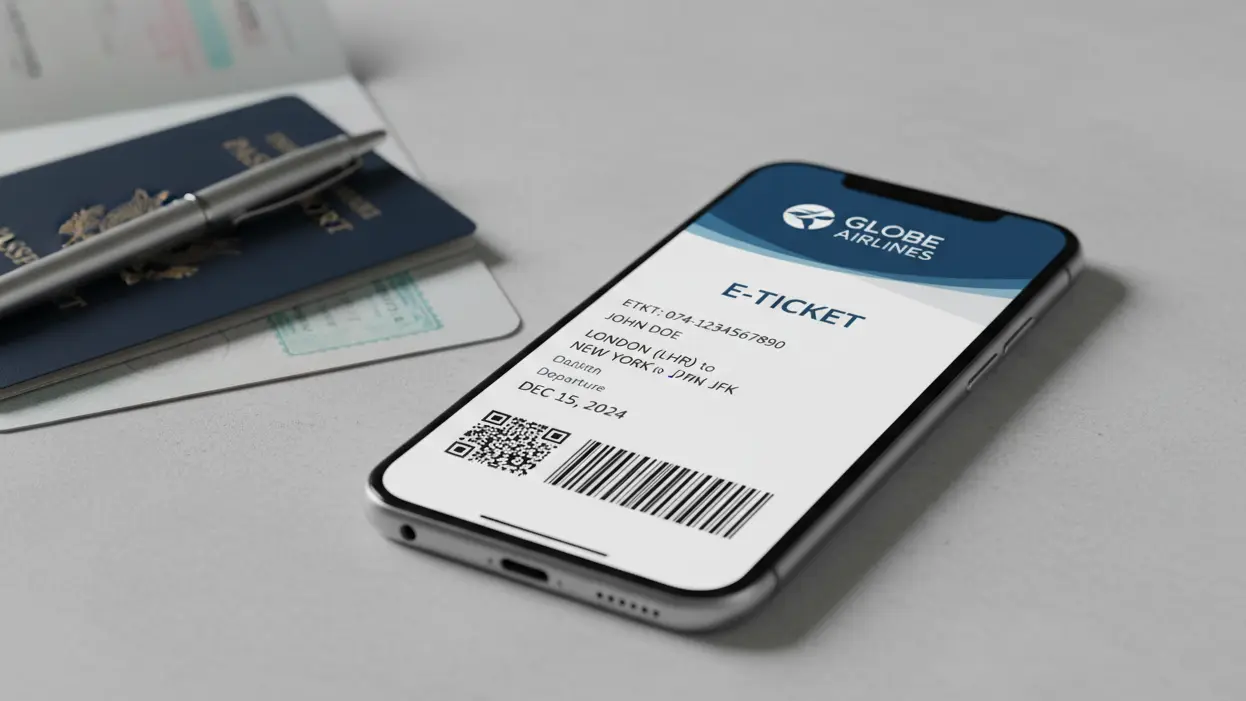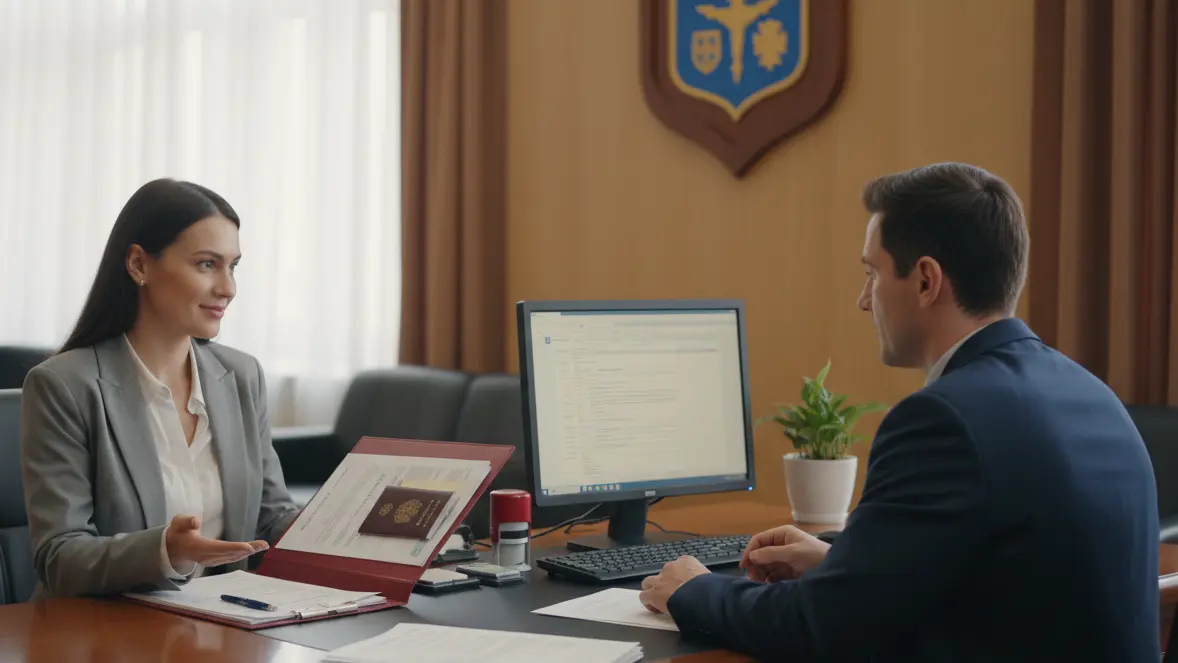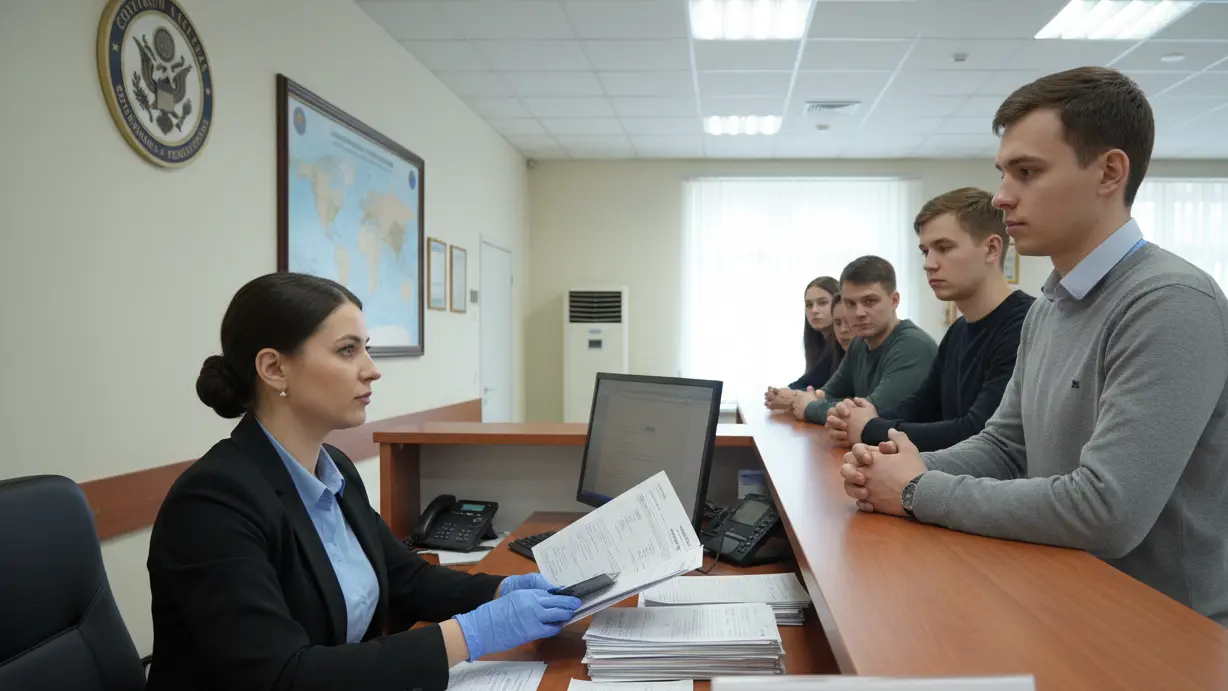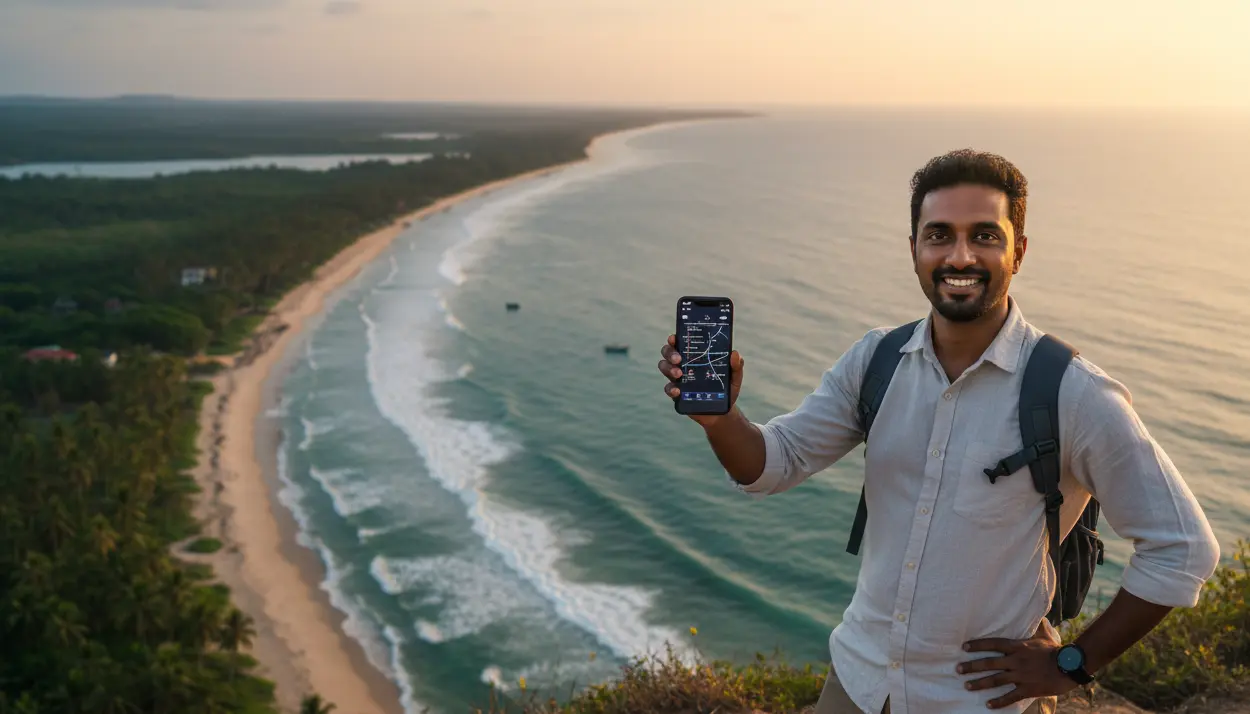Dummy Ticket With eTicket Number — How to Get Real Airline Verification Instantly
Some consulates won’t accept a plain flight reservation or PNR. They ask for an issued e-ticket number—the 13-digit code airlines generate after ticketing. For visa screening, that number signals a verifiable booking they can check in an airline’s “Manage Booking” tool. A dummy ticket with this eTicket number ensures your application stands out as genuine and compliant.
This guide explains what a “dummy ticket with an e-ticket number” actually is, when it’s required (and when a reservation is enough), and the safest ways to obtain one without risking cancellation fees or fraud. You’ll learn how to confirm that an e-ticket number is genuine, how long such tickets usually remain valid for visa review, and the common mistakes—wrong fare class, unverifiable third-party PDFs, mismatched names—that trigger delays. For more details on visa requirements, check our FAQ. Start your visa process today with our dummy ticket booking. If you're new to this, explore our blogs for tips, or learn about our team on the About Us page.
A dummy ticket with an eTicket number is a real airline reservation that includes both a Passenger Name Record (PNR) and a unique eTicket reference — making it fully verifiable through official airline systems. This format is preferred by many embassies because it looks identical to a confirmed flight booking and can be checked online for authenticity. DummyFlights.com provides eTicket-enabled dummy tickets accepted for Schengen, US, UK, and GCC visa applications, giving travelers instant embassy-approved documentation without the need to purchase expensive, non-refundable flights.
Last updated: October 2025 — verified against Schengen, UK, and UAE embassy documentation standards.
Table of Contents
Understanding these elements can transform your visa journey from stressful to straightforward. Many applicants overlook the nuances, leading to unnecessary hurdles. By prioritizing a verifiable dummy ticket, you align with embassy expectations right from the start.
Why Do You Need Dummy Tickets With eTicket Numbers

For many years, Indian travelers could simply attach a basic flight reservation or PNR to their visa application, and it worked just fine. But times have changed. More embassies and immigration departments are tightening their documentation rules, and now they want something stronger—proof that looks and feels like a genuine ticket.
That’s where a dummy ticket with an e-ticket number becomes essential. It’s not just another travel formality; it’s your shield against last-minute visa rejections and embarrassing delays at the counter. To deepen your knowledge, our FAQ covers common queries on documentation.
Let’s break down why this small shift in documentation has become such a big deal, especially for travelers from India heading to countries with stricter verification systems. If your embassy appointment is near, book a dummy ticket now and get instant delivery in minutes. Discover more strategies in our blogs.
When a Simple PNR Isn’t Enough Anymore
Not long ago, most embassies accepted PNR-based reservations as valid proof of onward travel. These bookings are real but not ticketed—they exist in the airline’s system for a short time to show intent to travel. But embassies in countries like France, Germany, the UAE, and Sri Lanka have started cross-verifying flight details online. When they do, a plain PNR sometimes fails to display any confirmation in the airline’s database.
That’s where things get tricky. When your visa officer can’t verify the booking, it may raise doubts about the authenticity of your documents—even if your intent is genuine. By contrast, an eTicket number provides an added layer of validation. It’s issued from the Global Distribution System (GDS), meaning your itinerary appears as an active record in the airline’s system. For insights into global standards, refer to the IATA guidelines on travel documentation.
So, instead of leaving your application open to unnecessary questions, an eTicket number does the talking for you. It instantly shows your booking is real, verifiable, and embassy-compliant. This is particularly vital for high-stakes applications where every detail counts.
Why Embassies and Airlines Prefer Verifiable eTickets
It’s not about being difficult—it’s about preventing fraud. With the rise of easily editable PDFs online, some travelers submitted fake or altered itineraries. Embassies responded by checking directly with airlines. They discovered that many of these fake documents didn’t exist in any airline database.
For that reason, certain visa-processing centers and consulates now specify “verifiable e-Ticket” in their documentation checklist. They want:
- A 13-digit eTicket number (e.g., 176-XXXXXXX) instead of just a PNR.
- GDS-based records that can be checked on the airline’s website.
- PDF copies showing the booking source and validity period.
This system filters out fake bookings while rewarding genuine applicants who use authorized services to obtain real, verifiable dummy tickets. Expanding on this, such practices not only streamline processing but also build long-term trust in the visa ecosystem.
For an Indian traveler, this makes sense. It saves you from unnecessary follow-ups, avoids embassy queries, and increases your credibility when applying for short-term tourist, student, or business visas. Consider how this integrates with other proofs like accommodation—our About Us page explains our holistic approach.
Situations Where You’ll Definitely Need an eTicket Number
Depending on where you’re going and how you’re applying, requirements can vary. But here are common situations where Indian travelers now find that e-ticket-based dummy tickets are non-negotiable:
- Schengen Visa Appointments (France, Germany, Italy): When applying in person or through VFS Global, your travel itinerary is sometimes verified on the airline’s system. Without an e-ticket number, officers can’t validate your booking.
- UAE Visa or Onward Travel Checks: The UAE’s immigration officers occasionally cross-check flight data, especially for travelers on visit or transit visas. Submitting an e-ticket-backed itinerary prevents last-minute scrutiny.
- Sri Lanka and Malaysia Entry Requirements: Some travelers report smoother processing when their itineraries contain an e-ticket number. It’s not mandatory—but it’s highly recommended.
- Visa Interviews for Canada or the UK: When applying offline or through agents, officers may ask for a “confirmed” flight proof. A dummy e-ticket fulfills that request without forcing you to buy a full ticket.
These scenarios highlight the evolving landscape of visa documentation. To stay ahead, always anticipate verification steps in your planning phase.
A Real-Life Example from Indian Travellers
Picture this: A student from Pune applies for a French student visa. She attaches a dummy booking with a PNR only. The consulate officer opens the airline’s website to verify, and nothing appears. The officer asks her to submit a verifiable ticket, causing a delay of two extra days.
Now imagine if she had submitted a dummy eTicket instead. The airline system would show an active reservation instantly, complete with a valid eTicket number. The officer verifies it within seconds, checks the box, and moves to the next document.
That’s the power of being proactive with your documentation. It’s not about spending more money—it’s about being smart and visa-ready. Real stories like this underscore why thousands turn to reliable services annually.
How This Impacts Students, Families, and Digital Nomads
Every category of traveler benefits differently:
- Students: When applying for study visas in Schengen or Gulf countries, using an eTicket helps maintain a clean, verifiable file that shows serious intent.
- Families and Group Travellers: A unified eTicket-based booking ensures all members have consistent itineraries, avoiding confusion at interviews or check-in.
- Digital Nomads and Frequent Travelers: For those applying repeatedly for short-stay visas, dummy eTickets reduce the hassle of buying and canceling full tickets each time.
In each case, verifiable documentation makes your travel record look professional and trustworthy—qualities embassies appreciate. This tailored approach ensures no group feels overlooked in the process.
Why Indian Applicants Shouldn’t Wait Until the Last Minute
Another common mistake we see among Indian applicants is waiting until a day before the visa appointment to arrange their flight proof. At that stage, panic sets in, and they either purchase real (non-refundable) tickets or download unverified templates online.
Here’s the smarter approach:
- Arrange your PNR dummy booking early, for initial submission or form-filling.
- Get your dummy eTicket 24–48 hours before your embassy appointment, when it will be verified.
This timing ensures your document remains valid through the verification process and minimizes the chance of expiry. Proactive planning like this can shave days off your overall timeline.
Proof That Works When It Matters Most
An eTicket number might look like a small detail, but for Indian travelers, it’s now one of the most practical tools for smooth visa approvals. It bridges the gap between a temporary booking and a verified record.
Whether you’re applying for a Schengen tourist visa, planning a business trip to Dubai, or arranging a family holiday to Europe, a dummy ticket with an eTicket number shows you’re organized, compliant, and ready to travel. Embrace this tool to elevate your application from standard to standout.
When You Actually Need an eTicket Number—and When a PNR Alone Does the Job
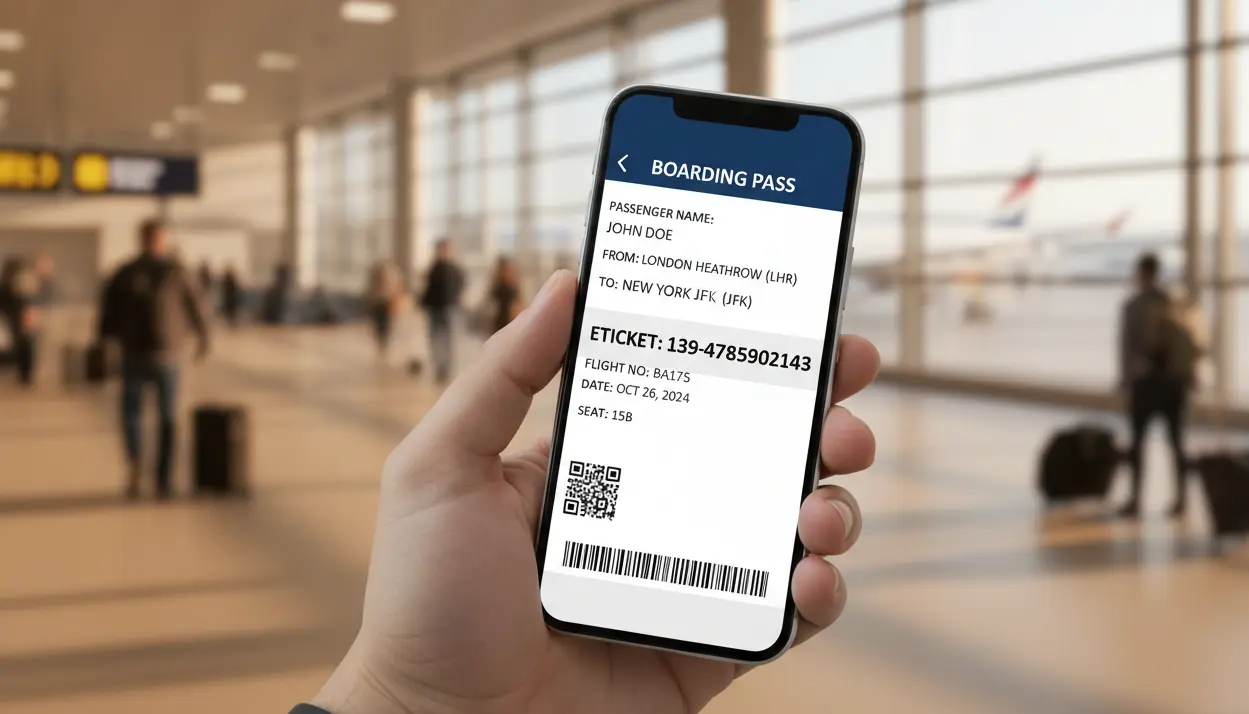
If you’ve ever stared at your visa checklist wondering whether your flight booking “counts,” you’re not alone. Many Indian travelers struggle to figure out the difference between a PNR and an eTicket number, and which one is required for their specific situation.
The truth? Both are legitimate, but embassies and consulates treat them differently depending on how your visa is processed. Knowing when to use each can save you time, money, and a lot of stress. 👉 Order your dummy ticket today for peace of mind.
Let’s decode this smartly so you can pick the right type of dummy ticket every single time. Need a verifiable reservation for your visa? Book a dummy ticket trusted by travelers worldwide. This decision tree is crucial for optimizing your submission.
PNR vs. eTicket Number—What Really Sets Them Apart
Both PNR and eTicket numbers come from the same airline reservation systems. The difference lies in what they prove:
- PNR (Passenger Name Record): This shows that your name, route, and flight details are recorded in the airline’s system. It’s a reservation—your seat is on hold, but not paid for.
- eTicket Number: This is a 13-digit code issued when the reservation is converted into a ticketed status. It appears on real bookings and is verifiable through airline websites or global distribution systems (like Amadeus or Saber).
So, while a PNR-based dummy booking shows your intent to travel, an e-Ticket-based dummy ticket goes one step further—it looks like a fully issued ticket, even though you haven’t actually paid the full airfare. Grasping this distinction empowers better choices across applications.
Visa Scenarios Where a Simple PNR Works Perfectly Fine
Let’s start with the good news. For many visa types, you don’t need an e-Ticket number at all. A verifiable PNR is enough to satisfy the “proof of travel” requirement.
Here’s where that applies:
- Online Visa Submissions: Countries like Thailand, Singapore, and Malaysia generally accept PNR-based flight reservations when you apply electronically. Their systems don’t verify bookings through the airline—only through the submitted PDF.
- E-Visa Applications: For e-visas, such as for Turkey or Kenya, authorities are more interested in your return intention than ticket verification.
- Visa on Arrival: For destinations where you receive a visa after landing, a dummy PNR reservation is often all you need as proof at the immigration counter.
- Preliminary Visa Stages: When filling out visa forms or sharing documents with travel agents, a PNR is more than sufficient.
In all these cases, your goal is to show intent, not confirmation. And since PNR dummy bookings usually stay valid for up to 14 days, they give you a comfortable window to prepare your full application. This flexibility is a game-changer for preliminary planning.
When an eTicket Number Becomes Absolutely Essential
Now, there are situations where you’ll need more than just a PNR. Certain embassies and visa processing centers have started verifying bookings directly with airlines. That’s where an eTicket number becomes your best friend.
Here’s when to go for a dummy eTicket:
- In-Person Visa Interviews (e.g., Schengen or UK): Officers sometimes check if your flight exists in the airline system. A PNR alone may not show up—but an eTicket will.
- UAE or Saudi Arabia Visa Applications: These countries occasionally cross-verify tickets at immigration to ensure you have a confirmed exit plan.
- Student and Work Visa Submissions: When you’re applying for a long-term stay or through VFS, an e-Ticket-based booking often looks more professional and authentic.
- Transit Visa Requests: If you’re transiting through Europe or the Middle East, your onward connection must be clearly shown as an e-Ticket.
When in doubt, remember this simple rule:
Online = PNR works.
In-person = e-Ticket is safer. Applying this rule consistently can prevent 90% of verification hiccups.
Duration and Validity—Timing It Right
A big part of using dummy tickets correctly is knowing how long they stay valid. Timing matters—especially for Indian travelers managing multiple documents.
Here’s a quick guide:
- Dummy Reservation (PNR only): Usually valid for up to 14 days. Great for early documentation, online forms, or embassy uploads.
- Dummy Ticket (with e-Ticket number): Valid for 24 to 48 hours. Best for visa interviews or in-person submissions where verification happens immediately.
Pro Tip: If your interview gets postponed, choose a provider (like DummyFlights.com) that allows free date changes or reissues. That way, you won’t have to buy a new one each time. This adaptability is key in dynamic travel schedules.
How Indian Travelers Can Mix and Match Both Types
Smart travelers often use both, depending on where they are in the process. Here’s a quick strategy that works for most applicants:
Step 1 – Start Early: Use a PNR dummy reservation when you first fill out your visa form or share documents with your travel consultant.
Step 2 – Upgrade Later: When your interview or embassy visit date is confirmed, switch to a dummy e-Ticket so it’s verifiable.
Step 3 – Verify Before Submission: Always check that the e-Ticket number shows up correctly on the airline’s verification page.
This approach gives you flexibility and keeps your documents consistent throughout your application journey. It's a layered strategy that mirrors professional travel planning.
The Hidden Benefit: Instant Embassy Trust
Think of it from the embassy officer’s perspective. They review hundreds of files a day—many with vague or fake itineraries. When your file includes a real eTicket number that checks out instantly, it saves them time. That positive first impression makes a subtle difference in how smoothly your application moves through the system.
It’s a small detail that signals professionalism and seriousness. You’re not just another applicant—you’re someone who knows the process and plays by the rules. This trust factor often tips the scales in borderline cases.
Common Mistakes to Avoid When Choosing Between PNR and e-Ticket
Many applicants lose valuable time because of simple missteps. Here are a few you can easily avoid:
- Using Unverifiable PDFs: If your PNR or e-Ticket can’t be checked online, embassies may flag it.
- Booking Too Early: e-Tickets expire fast, so don’t get them a week before your appointment.
- Wrong Travel Dates: Even a small mismatch between your form and dummy ticket can raise questions.
- Fake Generators: Avoid free online “ticket makers” that create random numbers. They’re not linked to any airline system and can lead to instant rejection.
Always work with verified sources that use GDS-based bookings. Sidestepping these pitfalls ensures a rejection-free path forward.
Making Smart, Stress-Free Choices
For Indian travellers juggling tight visa timelines, the choice between PNR and e-Ticket shouldn’t feel confusing. The key is to match your document type to your visa stage:
- PNR for planning.
- eTicket for proving.
Once you understand this rhythm, preparing your travel proofs becomes faster and simpler. Integrate this into your routine for repeatable success across future trips.
How To Get A Dummy Ticket With Eticket Number From India
Want to obtain a dummy ticket with an e-ticket number from India? Follow these steps, and you will have a verifiable document that embassies accept. We keep it simple and visa-focused so you get what you need without paying for a full fare. This process is designed for efficiency, taking just minutes from order to delivery.
Obtaining A Dummy Ticket For Visa Online
Here’s the straightforward route most Indian applicants follow.
- Choose a reputable provider that offers a dummy flight ticket online.
- Enter your travel details: name exactly as in passport, departure and return city, and approximate dates. Keep dates consistent with your visa form.
- Pick the type you need: a PNR-style reservation for early submission or a ticketed dummy for embassy verification.
- Pay securely and request instant delivery. This completes your dummy ticket booking.
- Receive a PDF that shows the PNR and the 13-digit eTicket number. Save it and verify it immediately on the airline’s site.
- Attach the PDF to your visa application or carry it to your in-person appointment.
Keep the purchase timing in mind. Get a PNR-style booking early in the process. Request the eTicket-style dummy 24 to 48 hours before your embassy visit. This avoids expiry and keeps the booking verifiable during the interview. For fast, embassy-approved proof of travel, book a dummy ticket today. Remember, accuracy in details prevents 95% of resubmission requests.
Key Features To Look For In A Reliable Provider
Not all suppliers are equal. Look for these features when you buy a genuine dummy ticket.
- GDS-based bookings, so the entry shows up in airline systems.
- A visible 13-digit eTicket number on the PDF.
- Clear expiration information for the PNR and eTicket.
- Instant email delivery and a PDF you can print.
- Reasonable, transparent fees with payment receipts.
- A policy for date changes in case your appointment moves.
Avoid sites that produce screenshots or online-generated dummy tickets with fake headers. These cannot be verified and may cause delays or rejections. If the provider offers a bundled dummy hotel booking, it can strengthen your application for Schengen or Gulf visas. But only add hotel proof when it matches the rest of your itinerary. Prioritizing these features guarantees a seamless experience.
Why DummyFlights.com Is Your Best Choice For Flight Reservation
When you need a quick, verified option, we provide both types of reservations that consulates and VFS accept. At DummyFlights.com, you can get a dummy ticket booking online with instant delivery. Our dummy reservation (PNR only) stays valid for 14 days.
Our dummy ticket (eTicket) includes a verifiable eTicket number and is valid for 2 days, ideal for embassy appointments. Pricing is transparent, and we offer urgent delivery when your schedule is tight. You can verify each booking on the airline’s official site after purchase. What sets us apart is our commitment to 100% verifiability, backed by years of traveler feedback.
Verification And Embassy Acceptance
Verification is the final step that turns a document into proof. Always check the booking immediately after you receive it.
- Use the airline’s “manage booking” or “check PNR” page to confirm the PNR shows correctly.
- Enter the 13-digit eTicket number on the airline’s verification tool if available. A verifiable flight reservation will return the passenger's name, flight numbers, and dates.
- Cross-check that the name exactly matches your passport and your visa form. Any mismatch will trigger questions.
If an embassy asks for confirmation during submission, having a verified flight reservation gives you a smoother outcome. Keep screenshots of the airline verification page in case the consulate requests additional proof. Also, carry the PDF and the email receipt to your interview. This multi-layered verification builds unshakeable confidence.
Quick Checklist Before You Submit
- Name matches passport.
- Dates match your visa form.
- PDF shows both PNR and e-Ticket numbers if required.
- You verified the booking on the airline’s site.
- You kept proof of payment for the booking.
Follow these steps, and you will present a tidy, verifiable travel record to the visa officer. If you prefer, we can also help you combine a flight with a dummy hotel booking for stronger support in countries that require accommodation proof. This checklist is your safeguard against oversight.
Using Dummy eTickets for Visa Applications From India
Once you’ve figured out how to get a dummy eTicket, the next step is using it wisely. The right timing, accurate details, and a bit of strategy can make your visa application process smoother and more confident.
Many travelers from India don’t realize that even a small mistake in the flight itinerary can confuse—or worse, visa cancellation. Let’s walk through how to use your dummy ticket for visa purposes the right way. Simplify your travel proof—complete your dummy ticket booking now. Effective usage turns potential pitfalls into strengths.
Get the Timing Right and Keep It Valid
Every dummy air ticket has an expiry. Whether you’re applying for a Schengen, UAE, or Canada visa, make sure your valid PNR covers your submission window. Ideally, your departure date should fall within 24–48 hours after your appointment if you’re using an eTicket type. This ensures the document remains an actual flight reservation during embassy verification.
If you’re submitting online, a longer-validity confirmed flight reservation or PNR version works better. Remember, dummy ticket airlines issue two main types: short-validity eTickets and long-validity reservations. Choose based on when your file will be reviewed. Mastering timing is akin to synchronizing a well-oiled machine.
Pair It With Accommodation and Insurance for Stronger Files
Consulates prefer seeing a complete picture. That’s why pairing your flight with a dummy hotel booking and travel insurance makes your submission more reliable. These elements together show intent, planning, and credibility.
For instance, many Schengen and Gulf embassies look for both flight and hotel details before approving entry. Submitting both proofs strengthens your chances of avoiding visa cancellation and unnecessary embassy queries.
If you’re wondering about dummy hotel booking benefits, they include:
- Showing confirmed accommodation without paying full rates upfront.
- Matching your mentioned flight itinerary and dates for easy cross-verification.
- Allowing flexibility for changes before you finalize your actual bookings.
This bundled approach creates a narrative of thorough preparation that resonates with reviewers.
Avoid the Trap of Fake or Free Tickets
While you might find sites claiming to offer free dummy tickets, be cautious. Most of these generate fake dummy ticket PDFs that aren’t connected to any airline system. Submitting one can backfire—your booking reference number won’t verify, and the embassy may doubt your entire file.
Always go for valid dummy tickets that can be checked on the airline’s website. Spending a small fee for a cheap dummy ticket is far better than risking rejection. After all, a minor investment with just payment protects you from bigger issues like delays or visa refusal. The cost of authenticity pales against rejection repercussions.
Use eTickets to Strengthen Proof of Return
Embassies love clarity. Submitting a dummy airline ticket or airline dummy ticket that includes your round-trip ticket details shows you plan to return after your visit. That’s your strongest proof of return—especially for short-term or visitor visas.
Always ensure your departure date and return date make sense with your purpose of travel. For example, a student heading to France shouldn’t show a 3-day itinerary; a business traveler visiting Dubai shouldn’t show a 90-day stay. The flight seats and schedule should reflect a realistic trip.
If you’re applying for countries that require exit visa procedures, like Saudi Arabia or some Gulf nations, your onward flight ticket plays a crucial role. Using a verifiable dummy eTicket helps you navigate exit visa procedures smoothly without buying a non-refundable actual flight ticket. This realism fortifies your case immeasurably.
Get Your Dummy Airline Ticket Right Every Time
To make sure you never face surprises during verification, follow this checklist before you get your dummy ticket:
- Check that the booking reference number and valid PNR appear clearly.
- Ensure the airline is legitimate—many reliable dummy ticket airlines partner with major carriers.
- Confirm both departure and return legs show the same traveler name.
- Match your travel dates to your hotel bookings and visa application form.
- Keep a soft copy and printed version handy in case of embassy questions.
If your provider accepts bank transfer or card payments, retain proof of payment as an added safeguard. This routine verification habit eliminates last-minute panics.
Why Realistic Details Make a Difference
When embassies verify a booking, they look for coherence. That’s why your flight numbers, routes, and dates must align perfectly with your application. Showing realistic timings and layovers—like a 2-hour connection on Singapore Airlines or a short layover with Air France—helps build trust.
A well-structured flight itinerary also looks more professional. For example:
- Departure: Delhi to Paris (Air India)
- Return: Paris to Delhi (Air France)
It feels credible because it matches popular routes used by real travelers. Embassies know the difference between a random airline ticket and one that fits a logical journey. Authenticity in details is the cornerstone of approval.
How Dummy eTickets Benefit Every Type of Traveler
Each traveler category gains something different from using a dummy ticket:
- Students: A dummy air ticket helps them demonstrate travel intent for visa interviews without paying in advance.
- Families: A single itinerary showing all members on one booking helps avoid confusion.
- Business travellers: An e-Ticket adds professionalism to files reviewed by strict consulates.
- Frequent travellers: A confirmed flight ticket serves as reusable proof for multiple short trips.
These dummy flight ticket benefits save time and protect against costly cancellations, since you can update dates anytime. Tailored benefits ensure universal appeal.
Smart Planning Beats Stressful Surprises
Using a dummy airline ticket the right way isn’t about cutting corners—it’s about planning smart. It keeps your documents organized, your trip believable, and your chances of approval high. Whether you’re applying for Europe, Asia, or the Middle East, a verifiable actual flight reservation shows you’re serious about your journey and prepared for every step.
Pair it with dummy hotel booking benefits, solid travel insurance, and a realistic timeline, and your file will stand out as complete and credible.
And remember—every good visa story starts with good preparation. With the right provider and clear understanding, a dummy flight ticket legal document can help you cross that embassy desk with confidence and peace of mind. Proactive steps like these yield lasting rewards in travel freedom.
What Travelers Are Saying
Embassy Playbook for Indian Applicants: When an e-Ticket Number Is Checked, and How
You want a visa file that passes quietly. No drama at the counter, no last-minute scramble. The easiest way to get there is to know exactly when officers check an e-ticket number and what they expect to see. This playbook demystifies the process for confident submissions.
How Embassies Actually Check Your Ticket
Most officers do fast, simple checks. They are not trying to catch you out. They just need proof they can verify.
They usually:
- Open the airline’s Manage Booking page and enter your last name and booking details.
- Look for a 13-digit e-ticket number that confirms the ticketed status.
- Scan dates, routes, and names for obvious errors.
- Note the booking source, such as a GDS or airline confirmation.
If the system returns your name, flight numbers, and dates, your file moves along. If nothing appears, the officer may ask for updated proof or hold your file for verification. Understanding their workflow allows you to preempt issues.
What Different Regions Usually Do
Each region has its habits. Knowing them helps you pick the safer option before you print anything.
In Schengen countries, you often meet an officer or submit through a center that can verify online. A plain PNR sometimes does not display. An e-ticket number removes that risk.
In the UK and Canada, agent-led submissions may ask for a confirmed itinerary for certain categories. A dummy e-ticket meets that need without you buying a nonrefundable fare.
In the Gulf, immigration officers can do spot checks at arrival or departure. A verifiable e-ticket shows you have a clear exit plan.
Across parts of Southeast Asia with e-visa portals, a clean PNR can be enough at upload. If you must attend in person later, switch to an e-ticket close to your visit. Regional nuances like these inform strategic choices.
What Your PDF Must Show at a Glance
Your document should be boring in the best way. Clear, verifiable, and consistent with your form.
Aim for:
- Passenger name exactly as in the passport.
- Routes and dates that match your visa application.
- Airline locator and 13-digit e-ticket number.
- Flight numbers and times in local format, not mixed time zones.
- Booking source or reference that ties back to a GDS or airline.
If you can verify your ticket on the airline site in under one minute, the officer likely can too. Clarity accelerates approval cycles significantly.
Timing That Keeps You Safe
Good timing prevents expired holds and awkward questions. Use reservations early, then switch to ticketed proof when it matters.
A simple plan:
- Start your file with a PNR-style reservation. It covers early uploads and agent reviews.
- Upgrade to an e-ticket 24 to 48 hours before your in-person appointment.
- If your date moves, ask for a reissue so the verification window stays open.
This rhythm works for students, families, first-timers, and digital nomads who apply often. It's a timeless framework for reliability.
Quick Decision Grid You Can Trust
You should not guess on the day you submit. Use this quick guide.
- Online portal only, no interview: PNR is usually fine.
- In-person interview, Schengen or UK: e-ticket is safer.
- Gulf entry with onward proof checks: e-ticket is safer.
- Transit visas that require a confirmed onward leg: an e-ticket is safer.
- Early stage form filling or agent review: PNR is fine.
When unsure, choose the option that the officer can verify in seconds, which is the e-ticket. This grid simplifies complex decisions.
Red Flags You Avoid by Going E-Ticket
A few common issues slow files. You can dodge them with clean, verifiable proof.
Watch for:
- Name order problems, especially middle names or initials.
- Stale PNRs that expired before the appointment.
- PDFs that look edited or use odd templates.
- Itineraries that do not match your stated purpose or timeline.
- Codeshare segments that do not display on one airline site. Use the operating carrier’s page if needed.
A single mismatch can trigger questions. Align details and you keep the process smooth. Vigilance here pays dividends.
Real Situations, Clear Plays
Different travelers face different pressure points. We plan for them.
Students
You often submit stacks of paperwork and then attend in person. Start with a PNR for early uploads. Switch to an e-ticket two days before your appointment. Keep your departure close to your program start and your return aligned with your plan, for example, semester break or initial course end.
First-Time Applicants
You want zero surprises. Book a simple round trip on common carriers and routes. Avoid creative routings. Verify that your e-ticket number shows on the airline site. Carry a printout and a screenshot of the verification page.
Family Visitors
Keep everyone on one itinerary if possible, or on linked records that show the same dates. Officers like consistency across the family. If one passport has a different name format, correct it on the booking before you print.
Digital Nomads and Frequent Travelers
You care about flexibility. Use a provider that can reissue quickly when plans shift. Keep your destination and exit leg realistic for the visa sought. When you pass through hubs like Dubai or Frankfurt, show a clear onward segment in ticketed form. Customized plays ensure tailored success.
Make Verification Effortless for the Officer
We design for the fastest possible yes. That means you give the officer what they need in the order they check it.
Do this:
- Put the e-ticket number and airline locator near the top of page one.
- Use legible fonts, standard PDF formatting, and local date formats.
- Include both segments for round-trip or onward travel.
- Keep a payment receipt or booking confirmation email ready. It shows authenticity if asked.
The officer should not hunt for details. When everything is obvious, your file moves. Effortless design is the secret to swift approvals.
What to Do if the Site Does Not Show Your Record
Sometimes the airline site is down, or a codeshare hides details. Do not panic. Solve it.
- Try the operating carrier’s site for the segment.
- Check that your name fields match the booking exactly.
- Confirm the PNR has not expired and the e-ticket is still open.
- Capture a new screenshot when the page loads correctly.
- If needed, ask for a same-day reissue so the record refreshes.
A clean refresh beats a tense counter conversation. Quick resolutions keep momentum intact.
You do not need luck to pass document checks. You need verifiable details, smart timing, and proof that opens fast on an airline page. Use a PNR to start, then bring an e-ticket to the table when an officer might look. That simple playbook saves time for everyone and keeps your trip on track. This comprehensive strategy equips you for any scenario.
How PNRs, GDS, And 13-Digit E-Ticket Numbers Actually Work
You submit a ticket PDF. An officer checks it in seconds. What happens in between is simple once you see the plumbing. Understand it and you will verify faster and avoid messy surprises. Demystifying the backend empowers informed decisions.
What Really Happens Behind A Booking
Let’s connect the dots. You enter traveler details. A system creates a reservation. Another system issues the ticket. Both pieces matter to your visa file.
Behind the scenes:
- Your name and itinerary create a Passenger Name Record called a PNR.
- The PNR lives in an airline system and in a Global Distribution System called a GDS.
- When ticketed, the system generates electronic coupons and a 13-digit e-ticket number.
- Airline websites read those records for “Manage Booking” checks.
If a PNR exists, your intent is recorded. If a ticket number exists, your booking is ticketed. Visa officers know this difference well. This interconnected system ensures global consistency.
PNR Vs E-Ticket
You do not need jargon. Think of a PNR as a container. It holds names, flights, and contact details. It proves that a booking was created.
An e-ticket number proves the booking was issued. That number links to coupons for each flight segment. It is the quick way to confirm status.
Use this rule of thumb:
- PNR only = reservation on hold. Good for early steps and online uploads.
- PNR plus e-ticket = ticketed booking. Best for interviews and spot checks.
Students use PNRs to start paperwork. First-time applicants and families bring e-tickets to the counter. Digital nomads switch to e-tickets close to verification. Simplicity in concepts drives practical application.
Where The 13-Digit Number Comes From
That long number is not random. It has a structure you can trust.
- The first three digits identify the airline. For example, Air India has its own prefix.
- The remaining digits form a unique serial number for your ticket.
- Each flight leg gets a coupon inside the ticket. Coupons show status such as Open or Used.
Why you care:
- Officers look for the prefix and total length.
- You can match the airline shown on the PDF with the prefix.
- If the format looks wrong, fix it before you submit.
This structure validates authenticity at a glance, streamlining checks.
How GDS Systems Fit Into Your Proof
We see GDS mentioned a lot. It matters because embassies want verifiable sources.
A GDS is a backbone that agents and airlines use to create and manage bookings. Examples include Amadeus and Sabre. When a provider issues your dummy ticket through a GDS, the record aligns with airline data.
What this means for you:
- Your PDF can be checked on the airline site or via a partner site.
- Names, routes, and dates appear the same in both places.
- You reduce the chance of “not found” screens during verification.
GDS integration is the invisible thread tying your proof to global standards.
Why Your Ticket Does Not Show Online Sometimes
You did everything right. The site says no record. It happens. There are common reasons and simple fixes.
Typical causes:
- The airline site is down or caching old data.
- You checked the marketing carrier. The operating carrier holds the live segment.
- Name fields do not match. Extra spaces or missing middle names cause misses.
- The PNR expired before ticketing.
- The e-ticket coupons are voided or not opened yet.
Easy actions:
- Try the operating carrier’s Manage Booking page.
- Enter last name and booking code exactly as printed.
- Give it an hour and refresh. Then take a new screenshot.
- Ask for a reissue if the validity window passed.
Families and groups should check that all travelers display together or as linked records. Students on codeshares should verify both carriers. Troubleshooting knowledge turns obstacles into opportunities.
How To Self-Verify Like An Officer
If you can verify your document in under a minute, the officer can too. Make it that easy every time.
Do this:
- Open the airline's Manage Booking page before you print.
- Confirm your name, dates, and flight numbers appear together.
- Look for the 13-digit e-ticket number or ticket status where available.
- Capture a clean screenshot showing the URL bar and timestamp.
- Keep the payment receipt or booking email handy.
For first-time applicants, this habit removes doubt. For digital nomads, it saves time during repeated applications. Self-verification is empowerment in action.
Edge Cases You Will See In The Wild
Not every itinerary is point-to-point. Complex trips add quirks you can manage with a checklist.
Open-jaw trips. Delhi to Paris, return from Amsterdam. Ensure both cities appear, and the ticket shows the correct turnaround.
Mixed carriers. One leg on a partner airline. Verify on the operating carrier site if the marketing site hides details.
Schedule changes. Airlines shift times. Refresh the PDF. Print the latest version with new segments.
Name order. Indian passports can include middle names and initials. Match the booking to the passport, not to social media spelling.
Children and seniors. Family bookings sometimes split into multiple PNRs. Link them or carry both codes to prove you travel together. Handling edges builds resilience.
Clean Data Habits That Save You Time
Good data beats long explanations. Keep your inputs tidy and your outputs standard.
Essentials:
- Use the exact passport name in the same order.
- Keep date formats local and consistent with your form.
- Avoid unusual routings that look like mileage runs.
- Put the PNR and e-ticket number near the top of page one.
- Ensure both outbound and return segments print on the same PDF.
Students should align travel dates with enrollment or orientation. Family visitors should match flight and accommodation dates. Digital nomads should show sensible layovers and a clear exit leg. Clean habits are the foundation of efficiency.
Picking The Right Proof For The Right Moment
You do not need a ticketed record for every step. You need the right record at the right time.
- Use a PNR to start forms, upload to portals, or brief an agent.
- Switch to an e-ticket 24 to 48 hours before any in-person check.
- Reissue if the appointment moves or the airline updates the schedule.
- Verify again just before you leave for the center.
This rhythm keeps your proof live when someone looks. It prevents expired holds and tense counter chats. Precision in selection optimizes outcomes.
A PNR shows a reservation. An e-ticket number proves the ticket was issued. Both live in airline and GDS systems that officers can check quickly. When your details match and the record opens fast, your file moves. Use reservations to prepare. Use e-tickets to pass verification. With that flow, students, first-time applicants, family visitors, and digital nomads all clear the desk with confidence. This backend knowledge elevates your expertise.
Dummy Ticket Safety: Legal Rules And Common Pitfalls
You want proof that works and never puts your visa at risk. The safest path is to use legitimate, verifiable reservations for documentation only. Let’s make the rules clear so you submit with confidence. Safety is paramount in every step.
What “Legal” Looks Like In Practice
A legal dummy ticket is a real reservation created in an airline or GDS system. It exists for a short window. It is used to show intent to travel during visa processing.
You are not using it to board a plane. You are not misrepresenting your identity. You are presenting a verifiable record that an officer can check in seconds.
When the record opens on an airline page and shows your name, route, and dates, you are on solid ground. Legality ensures ethical and effective use.
What Crosses The Line And Creates Risk
Problems start when a document cannot be verified or was never created in an airline system. That is when files get flagged and time is lost.
Avoid:
- Editable templates that let you type any number
- Screenshots that do not match airline formats
- Random generators that output fake ticket numbers
- Records with wrong names or swapped segments
- Bookings that already expired before your appointment
If an officer cannot find your booking, they may hold the file or ask for new proof. That slows everything. Awareness averts these risks entirely.
How To Vet A Provider Before You Pay
We want you to choose partners that keep your record clean. A quick checklist saves headaches later.
Look for:
- GDS-backed issuance that mirrors airline data
- A visible 13-digit e-ticket number when you choose ticketed proof
- Clear validity windows for PNR and ticketed versions
- Fast reissue or date change options
- A payment receipt with the order ID
- Support that replies with specifics, not vague promises
Walk away if you see only sample PDFs, no verifiability steps, or pressure tactics. Vetting protects your investment and integrity.
Privacy And Payment Hygiene That Protect You
Keep your data tight. You rarely need to share more than your passport name, itinerary, and contact details.
Smart habits:
- Use the exact passport name in the same order
- Share only the data the booking requires
- Pay through trusted gateways
- Keep receipts and confirmation emails
- Redact nonessential personal data if you share screenshots
Students and first-time applicants should store documents in one secure folder. Families should use one email thread for all traveler confirmations. Hygiene safeguards your journey.
The Ethical Way To Use A Dummy Ticket
We all want smooth processing. Ethics help you get there. The principle is simple. Be accurate. Be verifiable. Be consistent.
Do:
- Match dates to your purpose of travel
- Align flight times with accommodation and insurance
- Present realistic routings on known carriers
- Refresh the file if your appointment moves
Do not:
- Inflate stays to look impressive
- Show impossible connections
- Recycle a stale reservation from an old application
Officers see hundreds of files a week. Clean and coherent proofs earn trust. Ethics and efficacy go hand in hand.
If An Officer Asks Questions, Answer With Proof
Sometimes an officer wants an extra check. You can resolve it quickly when your paperwork is in order.
Respond with:
- A fresh screenshot of the airline's Manage Booking page
- The e-ticket number and airline locator
- Your payment receipt or provider confirmation
- A short note explaining any change in dates
Keep it factual and concise. When you give verifiable details in the officer’s format, the conversation ends well. Preparedness turns queries into quick wins.
Common Misconceptions You Can Ignore
Noise online creates confusion. Focus on what actually moves files.
Not true:
- “Every visa needs a paid ticket.” Many stages accept a reservation.
- “A PNR always shows online.” Some do not. E-tickets show more consistently.
- “PDF layout proves authenticity.” Officers trust what the system returns.
- “A free template is fine if it looks real.” If it does not verify, it fails.
True:
- Verifiable records pass faster than pretty PDFs
- Timing matters because holds expire
- Name order issues cause more delays than any other error
Dispelling myths sharpens your focus on facts.
Students, Families, And Digital Nomads Benefit Differently
Your situation shapes your safest choice. Plan for what the officer will look for in your category.
Students
- Use a PNR to begin forms and uploads
- Switch to an e-ticket 24 to 48 hours before the appointment
- Align dates with enrollment or orientation
Family Visitors
- Keep everyone on one itinerary or linked PNRs
- Match flights to accommodation dates
- Correct name formatting for children and seniors before printing
Digital Nomads And Frequent Travelers
- Pick providers that reissue within hours
- Keep routings simple with clear exit legs
- Store templates for repeat countries, but refresh every record
Differentiated benefits ensure inclusive safety.
Making The Right Choice
You do not need the same proof at every step. Choose the option that the officer can verify in that moment.
Use a PNR when:
- You submit through an online portal with document upload only
- You are in the early stage, and dates may change
- You need a longer validity window for form completion
Use an e-ticket when:
- You will attend an interview in person
- A center or consulate is known to cross-check live bookings
- You must show onward travel at immigration
When unsure, pick the record that opens fast and shows the 13-digit number. Choice mastery minimizes risks.
Handling Delays, Reschedules, And Airline Changes
Delays happen. You can stay ahead with a few quick plays.
- If your appointment moves, ask for a reissue so the new window stays valid
- If an airline shifts times, print the new itinerary and verify again
- If a site does not display the booking, try the operating carrier
- Keep both PDF and screenshot proof together in one folder
First-time applicants should label files by date. Families should add traveler initials to filenames. That prevents mix-ups at the counter. Adaptive handling keeps you agile.
A legal dummy ticket is simple. It is a real-time bound reservation created in airline systems for documentation. We use it to prove intent during verification. We do not use it to travel.
When your record verifies in seconds, you remove doubt. When your dates align with your plan, you look organized. When you refresh before the appointment, nothing expires on you.
Stay verifiable. Stay honest. Choose the right proof for the right moment. That is how you move through checks with a quiet yes and keep your trip on schedule. Safety through diligence is unbeatable.
More Resources
Get Your Dummy Ticket With Confidence Today
Securing a dummy ticket with an eTicket number doesn’t have to be stressful or confusing. Once you understand when a PNR works and when an eTicket number is essential, your visa preparation becomes effortless. Whether you’re applying for a Schengen visa, planning a business trip, or joining family abroad, a verified dummy ticket gives you reliable proof of travel without risking real money.
At DummyFlights.com, we make it quick, safe, and fully compliant with embassy standards. You can focus on your plans while we handle the technical details—your flight itinerary, verification, and timely delivery—all in one smooth process. Avoid delays and confusion—get your dummy ticket booking done safely online. Confidence comes from preparation, and we're here to deliver it.

